Yamnaya culture
 | |
| Alternative names |
|
|---|---|
| Geographical range | Eurasia |
| Period | Bronze Age |
| Dates | c. 3300–2600 BC |
| Preceded by | Samara culture, Khvalynsk culture, Dnieper–Donets culture, Sredny Stog culture, , Maykop culture |
| Followed by |
|
| Part of a series on |
| Indo-European topics |
|---|
 |
The Yamnaya culture (Russian: Я́мная культу́ра, IPA: ˈjamnəjə kulʲˈtura, lit. 'culture of pits') also known as the Yamnaya Horizon,[2] Yamna culture, Pit Grave culture or Ochre Grave culture, was a late Copper Age to early Bronze Age archaeological culture of the region between the Southern Bug, Dniester, and Ural rivers (the Pontic steppe), dating to 3300–2600 BC.[3] Its name derives from its characteristic burial tradition: Я́мная (romanization: yamnaya) is a Russian adjective that means 'related to pits (yama)', and these people used to bury their dead in tumuli (kurgans) containing simple pit chambers. The people of the Yamnaya culture were likely the result of a genetic admixture between the descendants of Eastern European Hunter-Gatherers[a] and people related to hunter-gatherers from the Caucasus,[4] an ancestral component which is often named "Steppe ancestry", with additional admixture of up to 18% from Early European Farmers.[5] Their material culture was very similar to the Afanasevo culture, and the populations of both cultures are genetically indistinguishable.[1] They lived primarily as nomads, with a chiefdom system and wheeled carts and wagons that allowed them to manage large herds.
They are also closely connected to Final Neolithic cultures, which later spread throughout Europe and Central Asia, especially the Corded Ware people and the Bell Beaker culture, as well as the peoples of the Sintashta, Andronovo, and Srubnaya cultures. Back migration from Corded Ware also contributed to Sintashta and Andronovo.[6] In these groups, several aspects of the Yamnaya culture are present.[b] Genetic studies have also indicated that these populations derived large parts of their ancestry from the steppes.[1][7][8][9]
The Yamnaya culture is identified with the late Proto-Indo-Europeans, and the Pontic-Caspian steppe is the strongest candidate for the Urheimat (original homeland) of the Proto-Indo-European language.
Origins[]
This section needs expansion. You can help by . (August 2019) |

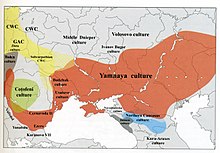
According to Pavel Dolukhanov (1996) the emergence of the Pit-Grave culture represents a social development of various local Bronze Age cultures, representing "an expression of social stratification and the emergence of chiefdom-type nomadic social structures", which in turn intensified inter-group contacts between essentially heterogeneous social groups.[13]
According to Mallory (1999), "The origin of the Yamnaya culture is still a topic of debate," with proposals for its origins pointing to both Khvalynsk and Sredny Stog.[14] The Khvalynsk culture (4700–3800 BCE)[15] (middle Volga) and the Don-based Repin culture (ca.3950–3300 BCE)[16] in the eastern Pontic-Caspian steppe, and the closely related Sredny Stog culture (c. 4500–3500 BCE) in the western Pontic-Caspian steppe, preceded the Yamnaya culture (3300–2500 BCE).[17][18]
According to Anthony (2007), the Yamnaya culture (3300–2600 BCE) originated in the Don–Volga area at ca. 3400 BCE,[19][3] preceded by the middle Volga-based Khvalynsk culture and the Don-based (c. 3950–3300 BC),[16][3] arguing that late pottery from these two cultures can barely be distinguished from early Yamnaya pottery.[20] Earlier continuity from eneolithic but largely hunter-gatherer Samara culture and influences from the more agricultural Dnieper–Donets II are apparent.
Alternatively, Parpola (2015) relates both the Corded ware culture and the Yamnaya culture to the late Tripolye culture.[21] He hypothesizes that "the Tripolye culture was taken over by PIE speakers by c. 4000 BCE,"[22] and that in its final phase the Tripolye culture expanded to the steppes, morphing into various regional cultures which fused with the late Sredny Stog pastoralist cultures, which, he suggests, gave rise to the Yamnaya culture.[23]
According to Anthony (2007), the early Yamnaya horizon spread quickly across the Pontic–Caspian steppes between c. 3400 and 3200 BC:[19]
The spread of the Yamnaya horizon was the material expression of the spread of late Proto-Indo-European across the Pontic–Caspian steppes.[24]
[...] The Yamnaya horizon is the visible archaeological expression of a social adjustment to high mobility – the invention of the political infrastructure to manage larger herds from mobile homes based in the steppes.[25]
The Yamnaya (Pit-grave) culture was succeeded in its western range by the Catacomb culture (2800–2200 BC); in the east, by the Poltavka culture (2700–2100 BC) at the middle Volga. These two cultures were followed by the Srubnaya culture (18th–12th century BC).
- Maps of the origins of Yamnaya culture

Sredny Stog culture (v.4500-3500 BCE)
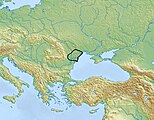
Usatovo culture (c. 3500–3000 BCE)

Khvalynsk culture (c. 4900–3500 BCE)
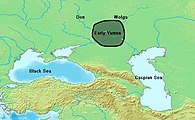
Location of early Yamnaya culture (3400 BCE), according to Anthony (2007)
Characteristics[]

Yamnaya culture was semi-nomadic, with some agriculture practiced near rivers, and a few fortified sites, the largest of which is Mikhaylovka.[26]
Mallory and Adams suggest that Yamnaya society may have had a tripartite structure of three differentiated social classes, although the evidence available does not demonstrate the existence of specific classes such as priests, warriors, and farmers.[27]
Characteristic for the culture are the burials in pit graves under kurgans (tumuli), often accompanied with animal offerings. Some graves contain large anthropomorphic stelae, with carved human heads, arms, hands, belts, and weapons.[28] The dead bodies were placed in a supine position with bent knees and covered in ochre. Some kurgans contained "stratified sequences of graves".[29] It has been argued that kurgan burials were rare, and reserved for special adults, who were predominantly, but not necessarily, male.[30] Status and gender are marked by grave goods and position, and in some areas, elite individuals are buried with complete wooden wagons.[31] Grave goods are more common in eastern Yamnaya burials, which are also characterized by a higher proportion of male burials and more male-centred rituals than western areas.[32]
In the northern Pontic steppes were excavated the oldest wheels in the world, which may tentatively be associated with the Indo-Europeans.[33] The Yamnaya culture possessed and utilized both two-wheeled carts and four-wheeled wagons, which are thought to have been oxen-drawn at this time, and there is evidence that they practised horse riding.[34]
Anthony[35] speculates that the Yamnaya ate a diet consisting of meat, milk, yogurt, cheese, and soups made from seeds and wild vegetables, and probably consumed mead.
Metallurgists and other craftsmen are given a special status in Yamnaya society, and metal objects are sometimes found in large quantities in elite graves. New metalworking technologies and weapon designs are used.[31]
Archaeogenetics[]
According to Jones et al. (2015) and Haak et al. (2015), autosomal tests indicate that the Yamnaya people were the result of a genetic admixture between two different hunter-gatherer populations: distinctive "Eastern Hunter-Gatherers" (EHG) with high affinity to the Mal'ta–Buret' culture or other, closely related people from Siberia[7] and a population of "Caucasus hunter-gatherers" (CHG) who probably arrived from the Caucasus or, less probably, what is now Iran.[36][4] Each of those two populations contributed about half the Yamnaya DNA.[8][4] This admixture is referred to in archaeogenetics as Western Steppe Herder (WSH) ancestry.
Admixture between EHGs and CHGs is believed to have occurred on the eastern Pontic-Caspian steppe starting around 5,000 BC, while admixture with Early European Farmers (EEF) happened in the southern parts of the Pontic-Caspian steppe sometime later. As Yamnaya Y-DNA is exclusively of the EHG and WHG type, displaying genetic continuity from the paternal lineages of the Dnieper-Donets culture, the admixture appears to have occurred predominantly between EHG males, and CHG and EEF females.
Haplogroup R1b, especially subclades of R1b-M269, is the most common Y-DNA haplogroup found among both the Yamnaya and modern-day Western Europeans.[1][7] Additionally, a minority are found to belong to haplogroup I2.[8] They are found to belong to a wider variety of mtDNA haplogroups, including U, T, and haplogroups associated with Caucasus Hunter-Gatherers and Early European Farmers.[37][38]
It has been hypothesized that an allele associated with lactase persistence (conferring lactose tolerance into adulthood) was brought to Europe from the steppe by Yamnaya-related migrations.[39][40][41][42]
People of the Yamnaya culture are believed to have had mostly brown eye colour, light to intermediate skin, and brown hair, with some variation.[43][44] Some individuals are believed to have carried a mutation to the KITLG gene associated with blond hair, as several individuals with Steppe ancestry are later found to carry this mutation. The Ancient North Eurasian population, who contributed significant ancestry to Western Steppe Herders, are believed to be the source of this mutation.[45] A study in 2015 found that Yamnaya had the highest ever calculated genetic selection for height of any of the ancient populations tested.[46][47]
The geneticist David Reich has argued that the genetic data supports the likelihood that the people of the Yamnaya culture were a "single, genetically coherent group" who were responsible for spreading many Indo-European languages.[48] Reich also argues that the genetic evidence shows that Yamnaya society was an oligarchy dominated by a small number of elite males.[49]
The genetic evidence for the extent of the role of the Yamnaya culture in the spread of Indo-European languages has however been questioned by Russian archaeologist Leo Klejn[50] and Balanovsky et al.,[51] who note a lack of male haplogroup continuity between the people of the Yamnaya culture and the contemporary populations of Europe.
Language[]
Marija Gimbutas identified the Yamnaya culture with the late Proto-Indo-Europeans (PIE) in her Kurgan hypothesis. The Pontic-Caspian steppe is the strongest candidate for the Urheimat (original homeland) of the Proto-Indo-European language, and evidence from linguistics[52] and genetics[7][53] suggests that the Yamnaya culture may be the homeland of the core Indo-European languages, excluding the Anatolian languages.[54]
According to David W. Anthony, the genetic evidence suggests that the leading clans of the Yamnaya were of EHG and WHG paternal origin[55] and implies that the Indo-European languages were the result of "a dominant language spoken by EHGs that absorbed Caucasus-like elements in phonology, morphology, and lexicon."[56]
[]
Western Europe[]

Haak et al. (2015) conducted a genome-wide study of 69 ancient skeletons from Europe and Russia. They concluded that Yamnaya autosomal characteristics are very close to the Corded Ware culture people, with an estimated 73% ancestral contribution from the Yamnaya DNA in the DNA of Corded Ware skeletons from Germany. The same study estimated a (38.8–50.4 %) ancestral contribution of the Yamnaya in the DNA of modern Central, and Northern Europeans, and an 18.5–32.6 % contribution in modern Southern Europeans; this contribution is found to a lesser extent in Sardinians (2.4–7.1 %) and Sicilians (5.9–11.6 %).[59][53][9] Haak et al. also note that their results state that haplogroup R-M269 spread into Europe from the East after 3000 BC.[60] Studies that analysed ancient human remains in Ireland and Portugal support the thesis that R-M269 was introduced in these places along with autosomal DNA from the Eastern European steppes.[61][62]
Autosomal tests also indicate that the Yamnaya are the most likely vector for "Ancient North Eurasian" admixture into Europe.[7] "Ancient North Eurasian" is the name given in literature to a genetic component that represents descent from the people of the Mal'ta–Buret' culture[7] or a population closely related to them. That genetic component is visible in tests of the Yamnaya people[7] as well as modern-day Europeans, but not of Europeans predating the Bronze Age.[63]
Eastern Europe and Finland[]
In the Baltic, Jones et al. (2017) found that the Neolithic transition – the passage from a hunter-gatherer economy to a farming-based economy – coincided with the arrival en masse of individuals with Yamnaya-like ancestry. This is different from what happened in Western and Southern Europe, where the Neolithic transition was caused by a population that came from the Near East, with Pontic steppe ancestry being detected from only the late Neolithic onward.[64]
Per Haak et al. (2015), the Yamnaya contribution in the modern populations of Eastern Europe ranges from 46.8% among Russians to 42.8% in Ukrainians. Finland has one of the highest Yamnaya contributions in all of Europe (50.4%).[65][c]
Central and South Asia[]
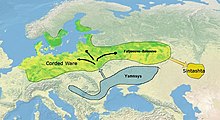

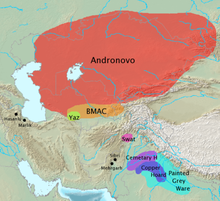
Studies also point to the strong presence of Yamnaya descent in the current nations of South Asia, especially in groups that are referred to as Indo-Aryans.[58][66] According to Pathak et al. (2018), the "North-Western Indian & Pakistani" populations (PNWI) showed significant Middle-Late Bronze Age Steppe (Steppe_MLBA) ancestry along with Yamnaya Early-Middle Bronze Age (Steppe_EMBA) ancestry, but the Indo-Europeans of Gangetic Plains and Dravidian people only showed significant Yamnaya (Steppe_EMBA) ancestry and no Steppe_MLBA. The study also noted that ancient south Asian samples had significantly higher Steppe_MLBA than Steppe_EMBA (or Yamnaya). The study identified the Rors as the population in South Asia with the highest proportion of Steppe ancestry.[66] Lazaridis et al. (2016) estimated (6.5–50.2 %) steppe-related admixture in South Asians, though the proportion of Steppe ancestry varies widely across ethnic groups.[67][d] According to Narasimhan et al. (2019), the Yamnaya-related ancestry, termed Western_Steppe_EMBA, that reached central and south Asia was not the initial expansion from the steppe to the east, but a secondary expansion that involved a group possessing ~67% Western_Steppe_EMBA ancestry and ~33% ancestry from the European cline. This group included people similar to that of Corded Ware, Srubnaya, Petrovka, and Sintashta. Moving further east in the central steppe, it acquired ~9% ancestry from a group of people that possessed West Siberian Hunter Gatherer ancestry, thus forming the Central Steppe MLBA cluster, which is the primary source of steppe ancestry in South Asia, contributing up to 30% of the ancestry of the modern groups in the region.[58]
According to Unterländer et al. (2017), Iron Age Scythians from the southern Ural region, East Kazakhstan and Tuva can best be described as a mixture of Yamnaya-related ancestry and an East Asian component, the latter occurring at only trace levels – if at all – among earlier steppe inhabitants.[68]
Artifacts[]
- From the Hermitage Museum collections
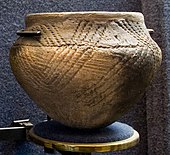
Corded ware pot
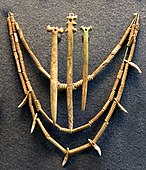
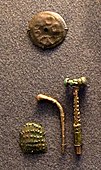

See also[]
- Kurgan
- Kurgan stelae
- Butmir culture
- Vinča culture
- Beaker culture
- Baden culture
- Botai culture
- Khvalynsk culture
- Mamai-Hora
- Samara culture
- Sintashta culture
- Yersinia pestis
- Proto-Indo-Europeans
Notes[]
- ^ The Eastern European hunter-gatherers were themselves mostly descended from ancient North Eurasians, related to the palaeolithic Mal'ta–Buret' culture.
- ^ Yamnayan cultural aspects, for example, were horse-riding, burial styles, and to some extent the pastoralist economy.
- ^ Per Haak et al. (2015), adding a north-Siberian people as a fourth reference population improves residuals for northeastern European populations. This accounts for the higher than expected Yamnaya contribution and brings it down to expected levels (67.8–50.4 % in Finns, 64.9–46.8 % in Russians).
- ^ Lazaridis et al. (2016) Supplementary Information, Table S9.1: "Kalash – 50.2 %, Tiwari Brahmins – 44.1 %, Gujarati (four samples) – 46.1 % to 27.5 %, Pathan – 44.6 %, Burusho – 42.5 %, Sindhi – 37.7 %, Punjabi – 32.6 %, Balochi – 32.4 %, Brahui – 30.2 %, Lodhi – 29.3 %, Bengali – 24.6 %, Vishwabhramin – 20.4 %, Makrani – 19.2 %, Mala – 18.4 %, Kusunda – 8.9 %, Kharia – 6.5 %."
References[]
- ^ Jump up to: a b c d Allentoft 2015.
- ^ Anthony 2007, p. 307.
- ^ Jump up to: a b c Morgunova & Khokhlova 2013.
- ^ Jump up to: a b c "Europe's fourth ancestral 'tribe' uncovered". BBC. 16 November 2015.
- ^ Wang, Chuan-Chao; Reinhold, Sabine; Kalmykov, Alexey; Wissgott, Antje; Brandt, Guido; Jeong, Choongwon; Cheronet, Olivia; Ferry, Matthew; Harney, Eadaoin; Keating, Denise; Mallick, Swapan (4 February 2019). "Ancient human genome-wide data from a 3000-year interval in the Caucasus corresponds with eco-geographic regions". Nature Communications. 10 (1). doi:10.1038/s41467-018-08220-8. ISSN 2041-1723. PMC 6360191.
- ^ Novembre 2015, "evidence to support theories of a back-migration from Corded Ware-related populations that contributed to the origins of the Sintashta culture in the Urals and their descendants, the Andronovo."
- ^ Jump up to: a b c d e f g Haak et al. 2015.
- ^ Jump up to: a b c Mathieson, et al. 2015.
- ^ Jump up to: a b Gibbons, Ann (10 June 2015). "Nomadic herders left a strong genetic mark on Europeans and Asians". Science. AAAS.
- ^ Anthony 2007, p. 300-370.
- ^ Jump up to: a b Nordgvist & Heyd 2020.
- ^ Mallory 1999.
- ^ Dolukhanov 1996, p. 94.
- ^ Mallory 1999, p. 215.
- ^ Anthony 2007, p. 182.
- ^ Jump up to: a b Anthony 2007, p. 275.
- ^ Anthony 2007, p. 300.
- ^ Mallory 1999, p. 210-211.
- ^ Jump up to: a b Anthony 2007, p. 321.
- ^ Anthony 2007, pp. 274–277, 317–320.
- ^ Parpola 2015, p. 49.
- ^ Parpola 2015, p. 45.
- ^ Parpola 2015, p. 47.
- ^ Anthony 2007, pp. 301–302.
- ^ Anthony 2007, p. 303.
- ^ Mallory 1997, p. 212.
- ^ J. P. Mallory; Douglas Q. Adams, eds. (1997). Encyclopedia of Indo-European culture. London: Fitzroy Dearborn. p. 653. ISBN 1-884964-98-2. OCLC 37931209.
- ^ Anthony 2007, p. 339.
- ^ Anthony 2007, p. 319.
- ^ author., Anthony, David. The Horse, the Wheel, and Language. OCLC 1102387902.
- ^ Jump up to: a b J., Harrison, Richard. The transformation of Europe in the third millennium BC: the example of "Le Petit-Chasseur I + II" (Sion, Valais, Switzerland). p. 196. OCLC 718304072.
- ^ Anthony 2007, p. 305.
- ^ Holm, Hans J. J. G. (2019): The Earliest Wheel Finds, their Archeology and Indo-European Terminology in Time and Space, and Early Migrations around the Caucasus. Series Minor 43. Budapest: ARCHAEOLINGUA ALAPÍTVÁNY. ISBN 978-615-5766-30-5. With 306 references, six greyscaled and coloured images, and miniatur images within the table of 130 representative finds, including brandnew ones in Germany and Western China.
- ^ P., Mallory, J. (2003) [1989]. In search of the Indo-Europeans : language, archaeology, and myth. Thames and Hudson. p. 213. ISBN 0-500-27616-1. OCLC 886668216.
- ^ Anthony 2007, p. 430.
- ^ Jones et al. 2015.
- ^ Wang 2019.
- ^ Eske, Allentoft; Morten E. Pokutta; Dalia Willerslev (2015). Population genomics of Bronze Age Eurasia. University of Copenhagen, Denmark. OCLC 1234973657.
- ^ Segurel, Laure (2020). "Why and when was lactase persistence selected for? Insights from Central Asian herders and ancient DNA". PLOS Biology. 18 (6): e3000742. doi:10.1371/journal.pbio.3000742. PMC 7302802. PMID 32511234. "Furthermore, ancient DNA studies found that the LP mutation was absent or very rare in Europe until the end of the Bronze Age [26–29] and appeared first in individuals with steppe ancestry [19,20]. Thus, it was proposed that the mutation originated in Yamnaya-associated populations and arrived later in Europe by migration of these steppe herders."
- ^ Callaway, Ewen. "DNA data explosion lights up the Bronze Age". Nature. "the 101 sequenced individuals, the Yamnaya were most likely to have the DNA variation responsible for lactose tolerance, hinting that the steppe migrants might have eventually introduced the trait to Europe"
- ^ Furholt, Martin (2018). "Massive Migrations? The Impact of Recent DNA Studies on our View of Third Millennium Europe". European Journal of Archaeology. 21 (2): 159–191. doi:10.1017/eaa.2017.43. "For example, one lineage could have a biological evolutionary advantage over the other. Allentoft et al. (2015: 171) have found a remarkably high rate of lactose tolerance among individuals connected to Yamnaya and to Corded Ware, as opposed to the majority of Late Neolithic individuals."
- ^ Saag, L (2020). "Human Genetics: Lactase Persistence in a Battlefield". Current Biology. 30 (21): R1311–R1313. doi:10.1016/j.cub.2020.08.087. PMID 33142099. S2CID 226229587.
- ^ Gibbons, A. (24 July 2015). "Revolution in human evolution". Science. 349 (6246): 362–366. doi:10.1126/science.349.6246.362. ISSN 0036-8075.
- ^ Hanel, Andrea; Carlberg, Carsten (September 2020). "Skin colour and vitamin D: An update". Experimental Dermatology. 29 (9): 864–875. doi:10.1111/exd.14142. ISSN 0906-6705.
- ^ Mathieson, Iain; Alpaslan-Roodenberg, Songül; Posth, Cosimo; Szécsényi-Nagy, Anna; Rohland, Nadin; Mallick, Swapan; Olalde, Iñigo; Broomandkhoshbacht, Nasreen; Candilio, Francesca; Cheronet, Olivia; Fernandes, Daniel (March 2018). "The genomic history of southeastern Europe". Nature. 555 (7695): 197–203. doi:10.1038/nature25778. ISSN 1476-4687. PMC 6091220. PMID 29466330.
- ^ Heyd, Volker (April 2017). "Kossinna's smile". Antiquity. 91 (356): 348–359. doi:10.15184/aqy.2017.21. hdl:10138/255652. ISSN 0003-598X.
- ^ Mathieson, Iain; Lazaridis, Iosif; Rohland, Nadin; Mallick, Swapan; Patterson, Nick; Roodenberg, Songül Alpaslan; Harney, Eadaoin; Stewardson, Kristin; Fernandes, Daniel; Novak, Mario; Sirak, Kendra (24 December 2015). "Genome-wide patterns of selection in 230 ancient Eurasians". Nature. 528 (7583): 499–503. doi:10.1038/nature16152. ISSN 0028-0836. PMC 4918750. PMID 26595274.
- ^ Reich, David (2018). Who we are and how we got here: ancient DNA and the new science of the human past. Oxford, United Kingdom. p. 121. ISBN 0-19-882125-5. OCLC 1006478846.
- ^ Reich, David (2018). Who we are and how we got here: ancient DNA and the new science of the human past. Oxford, United Kingdom. p. 239. ISBN 0-19-882125-5. OCLC 1006478846.
- ^ Klejn, Leo (2017). "The Steppe Hypothesis of Indo-European Origins Remains to be Proven". Acta Archaeologica. 88 (1): 193–204. doi:10.1111/j.1600-0390.2017.12184.x.
- ^ Balanovsky, O.; Chukhryaeva, M.; Zaporozhchenko, V. (2017). "Genetic differentiation between upland and lowland populations shapes the Y-chromosomal landscape of West Asia". Human Genetics. 136 (4): 437–450. doi:10.1007/s00439-017-1770-2. PMID 28281087. S2CID 3735168."The ancient Yamnaya samples are located on the "eastern" R-GG400 branch of haplogroup R1b-L23, showing that the paternal descendants of the Yamnaya still live in the Pontic steppe and that the ancient Yamnaya population was not an important source of paternal lineages in present-day West Europeans."
- ^ Jump up to: a b Anthony 2007, p. [page needed].
- ^ Jump up to: a b Zimmer, Carl (10 June 2015). "DNA Deciphers Roots of Modern Europeans". New York Times. Retrieved 2020-12-12.
- ^ Olsen, Birgit A.; Olander, Thomas; Kristiansen, Kristian (23 August 2019), Tracing the Indo-Europeans, Oxbow Books, pp. 1–6, doi:10.2307/j.ctvmx3k2h.6, ISBN 978-1-78925-273-6
- ^ Anthony 2019b, p. 36.
- ^ Anthony 2019a, p. 1-19.
- ^ Anthony 2017.
- ^ Jump up to: a b c Narasimhan et al. 2019.
- ^ Haak et al. 2015, pp. 121–124.
- ^ Haak et al. 2015, p. 5.
- ^ Cassidy et al. 2016.
- ^ Martiniano, et al. 2017.
- ^ Lazaridis et al. 2014.
- ^ Jones et al. 2017.
- ^ Haak et al. 2015, pp. 121–122.
- ^ Jump up to: a b Pathak et al. 2018.
- ^ Lazaridis et al. (2016).
- ^ Unterländer et al. 2017.
Notes[]
- ^ See also Eurogenes Blog (December 18, 2017), Corded Ware as an offshoot of Hungarian Yamnaya (Anthony 2017)
Sources[]
- Allentoft, Morten E.; et al. (2015). "Population genomics of Bronze Age Eurasia". Nature. 522 (7555): 167–172. Bibcode:2015Natur.522..167A. doi:10.1038/nature14507. PMID 26062507. S2CID 4399103.
- Anthony, David W. (2007). The Horse, the Wheel, and Language: How Bronze-Age Riders from the Eurasian Steppes Shaped the Modern World. Princeton University Press. ISBN 978-0691058870.
- Anthony, David (2017). "Archaeology and Language: Why Archaeologists Care About the Indo-European Problem". In Crabtree, P.J.; Bogucki, P. (eds.). European Archaeology as Anthropology: Essays in Memory of Bernard Wailes.
- Anthony, David (Spring–Summer 2019a). "Archaeology, Genetics, and Language in the Steppes: A Comment on Bomhard". Journal of Indo-European Studies. 47 (1–2). Retrieved 2020-01-09.
- Anthony, David W. (2019b). "Ancient DNA, Mating Networks, and the Anatolian Split". In Serangeli, Matilde; Olander, Thomas (eds.). Dispersals and Diversification: Linguistic and Archaeological Perspectives on the Early Stages of Indo-European. BRILL. pp. 21–54. ISBN 978-9004416192.
- Cassidy LM, Martiniano R, Murphy EM, Teasdale MD, Mallory J, Hartwell B, Bradley DG (2016). "Neolithic and Bronze Age migration to Ireland and establishment of the insular Atlantic genome". PNAS. 113 (2): 368–373. Bibcode:2016PNAS..113..368C. doi:10.1073/pnas.1518445113. PMC 4720318. PMID 26712024.
- Dolukhanov, Pavel M. (1996), The Early Slavs: Eastern Europe from the Initial Settlement to the Kievan Rus, New York: Longman, ISBN 0-582-23627-4
- Fortson, Benjamin W. (2004), Indo-European Language and Culture: An Introduction, Blackwell Publishing
- Gallego-Llorente M, Connell S, Jones ER, Merrett DC, Jeon Y, Eriksson A, et al. (2016). "The genetics of an early Neolithic pastoralist from the Zagros, Iran". Scientific Reports. 6: 31326. Bibcode:2016NatSR...631326G. doi:10.1038/srep31326. PMC 4977546. PMID 27502179.
- Haak W, Lazaridis I, Patterson N, Rohland N, Mallick S, Llamas B, et al. (2015). "Massive migration from the steppe was a source for Indo-European languages in Europe". Nature. 522 (7555): 207–211. arXiv:1502.02783. Bibcode:2015Natur.522..207H. bioRxiv 10.1101/013433. doi:10.1038/nature14317. PMC 5048219. PMID 25731166.
- Jeong, Choongwon; Balanovsky, Oleg; Lukianova, Elena; Kahbatkyzy, Nurzhibek; et al. (29 April 2019). "The genetic history of admixture across inner Eurasia languages in Europe". Nature Ecology and Evolution. Nature Research. 3 (6): 966–976. doi:10.1038/s41559-019-0878-2. hdl:10871/36562. PMC 6542712. PMID 31036896.
- Jones, Eppie R.; Gonzalez-Fortes, Gloria; Connell, Sarah; Siska, Veronika; et al. (2015). "Upper Palaeolithic genomes reveal deep roots of modern Eurasians". Nature Communications. 6: 8912. Bibcode:2015NatCo...6.8912J. doi:10.1038/ncomms9912. PMC 4660371. PMID 26567969.
- Jones ER, Zarina G, Moiseyev V, Lightfoot E, Nigst PR, Manica A, Pinhasi R, Bradley DG (2017). "The Neolithic transition in the Baltic was not driven by admixture with early European farmers". Current Biology. 27 (4): 576–582. doi:10.1016/j.cub.2016.12.060. PMC 5321670. PMID 28162894.
- Kuzmina, Elena E. (2007). Mallory, J. P. (ed.). The Origin of the Indo-Iranians. BRILL. ISBN 978-9004160545.
- Lazaridis, Iosif; Patterson, Nick; Mittnik, Alissa; Renaud, Gabriel; et al. (2014). "Ancient human genomes suggest three ancestral populations for present-day Europeans". Nature. 513 (7518): 409–413. arXiv:1312.6639. Bibcode:2014Natur.513..409L. doi:10.1038/nature13673. PMC 4170574. PMID 25230663.
- Lazaridis I, Nadel D, Rollefson G, Merrett DC, Rohland N, Mallick S, et al. (16 June 2016). "The genetic structure of the world's first farmers". bioRxiv 10.1101/059311. Supplementary Information}}
Lazaridis I, Nadel D, Rollefson G, Merrett DC, Rohland N, Mallick S, et al. (25 July 2016). "Genomic insights into the origin of farming in the ancient Near East". Nature (published August 2016). 536 (7617): 419–424. Bibcode:2016Natur.536..419L. doi:10.1038/nature19310. PMC 5003663. PMID 27459054. - Mallory, J. P. (1997), "Yamna Culture", Encyclopedia of Indo-European Culture, Fitzroy Dearborn
- Mallory, J.P. (1999), In Search of the Indo-Europeans: Language, Archaeology, and Myth (reprint ed.), London: Thames & Hudson, ISBN 978-0-500-27616-7
- Martiniano, R, et al. (2017). "The population genomics of archaeological transition in west Iberia: Investigation of ancient substructure using imputation and haplotype-based methods". PLOS Genet. 13 (7): e1006852. doi:10.1371/journal.pgen.1006852. PMC 5531429. PMID 28749934.
- Mathieson, Iain; et al. (10 October 2015). "Eight thousand years of natural selection in Europe". bioRxiv 10.1101/016477.
Mathieson, Iain; et al. (23 November 2015). "Genome-wide patterns of selection in 230 ancient Eurasians". Nature (published 24 December 2015). 528 (7583): 499–503. Bibcode:2015Natur.528..499M. doi:10.1038/nature16152. PMC 4918750. PMID 26595274. - Mathieson, Iain; et al. (21 February 2018). "The Genomic History of Southeastern Europe". Nature. Nature Research. 555 (7695): 197–203. Bibcode:2018Natur.555..197M. doi:10.1038/nature25778. PMC 6091220. PMID 29466330.
- Morgunova, Nina; Khokhlova, Olga (2013). "Chronology and Periodization of the Pit-Grave Culture in the Area Between the Volga and Ural Rivers Based on 14C Dating and Paleopedological Research". Radiocarbon. 55 (2–3): 1286–1296. doi:10.2458/azu_js_rc.55.16087. ISSN 0033-8222.
- Narasimhan VM, Patterson N, Moorjani P, Rohland N, et al. (2019). "The formation of human populations in South and Central Asia". Science. 365 (6457): eaat7487. doi:10.1126/science.aat7487. PMC 6822619. PMID 31488661.
- Nordgvist, Kerkko; Heyd, Volker (2020). "The Forgotten Child of the Wider Corded Ware Family: Russian Fatyanovo Culture in Context". Proceedings of the Prehistoric Society. 86: 65–93. doi:10.1017/ppr.2020.9. S2CID 228923806.
- Novembre, John (11 June 2015). "Ancient DNA steps into the language debate" (PDF). Nature. 522 (7555): 164–165. doi:10.1038/522164a. PMID 26062506. S2CID 205085294.
- Parpola, Asko (2015), The Roots of Hinduism, Oxford University Press
- Pashnick, Jeff (August 2014). Genetic Analysis of Ancient Human Remains from the Early Bronze Age Cultures of the North PonticSteppe Region (Masters Theses thesis). 737. Grand Valley State University. Retrieved 2020-01-12.
- Pathak AK, Kadian A, Kushniarevich A, Montinaro F, Mondal M, Ongaro L, et al. (6 December 2018). "The Genetic Ancestry of Modern Indus Valley Populations from Northwest India". The American Journal of Human Genetics. 103 (6): 918–929. doi:10.1016/j.ajhg.2018.10.022. PMC 6288199. PMID 30526867.
- Unterländer, Martina; Palstra, Friso; Lazaridis, Iosif; Pilipenko, Aleksandr; Hofmanová, Zuzana; Groß, Melanie; et al. (2017). "Ancestry and demography and descendants of Iron Age nomads of the Eurasian Steppe". Nature Communications. 8: 14615. Bibcode:2017NatCo...814615U. doi:10.1038/ncomms14615. ISSN 2041-1723. PMC 5337992. PMID 28256537.
- Wang, Chuan-Chao (4 February 2019). "Ancient human genome-wide data from a 3000-year interval in the Caucasus corresponds with eco-geographic regions Eurasia". Nature Communications. Nature Research. 10 (1): 590. bioRxiv 10.1101/322347. doi:10.1038/s41467-018-08220-8. PMC 6360191. PMID 30713341.
- Wilde S, Timpson A, Kirsanow K, Kaiser E, Kayser M, Unterländer M, et al. (2014). "Direct evidence for positive selection of skin, hair, and eye pigmentation in Europeans during the last 5,000 y". Proceedings of the National Academy of Sciences of the United States of America. 111 (13): 4832–4837. Bibcode:2014PNAS..111.4832W. doi:10.1073/pnas.1316513111. PMC 3977302. PMID 24616518.
External links[]
| Wikimedia Commons has media related to Yamna culture. |
- "Genetic study revives debate on origin and expansion of Indo-European Languages". Science Daily. March 2015.
- Indo-European archaeological cultures
- Archaeological cultures of Eastern Europe
- Bronze Age cultures of Europe
- Chalcolithic cultures of Europe
- Archaeological cultures in Ukraine
- Archaeological cultures in Russia
- Archaeological cultures in Moldova
- Archaeology of Kazakhstan
- 4th millennium BC
- Prehistoric Russia







